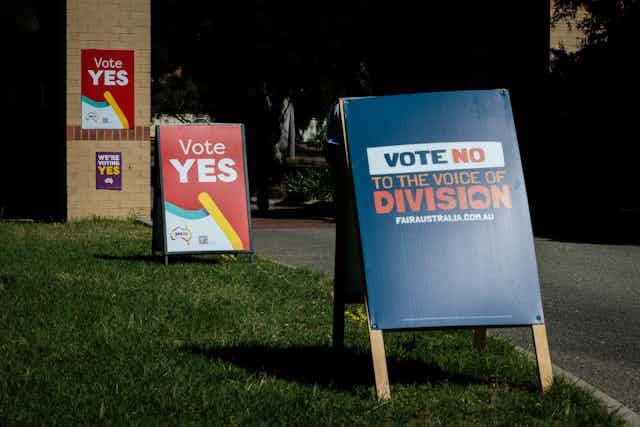A majority of Australian voters have rejected the proposal to establish an Aboriginal and Torres Strait Islander Voice to Parliament, with the final results likely to be about 40% voting “yes” and 60% voting “no”.
What was the referendum about?
In this referendum, Australians were asked to vote on whether to establish an Aboriginal and Torres Strait Islander Voice to Parliament. The Voice was proposed as a means of recognising Aboriginal and Torres Strait Islander peoples as the First Peoples of Australia in the Constitution.
The Voice proposal was a modest one. It was to be an advisory body for the national parliament and government. Had the referendum succeeded, Australia’s Constitution would have been amended with a new section 129:
In recognition of Aboriginal and Torres Strait Islander peoples as the First Peoples of Australia:
i. there shall be a body, to be called the Aboriginal and Torres Strait Islander Voice
ii. the Aboriginal and Torres Strait Islander Voice may make representations to the Parliament and the Executive Government of the Commonwealth on matters relating to Aboriginal and Torres Strait Islander peoples
iii. the Parliament shall, subject to this Constitution, have power to make laws with respect to matters relating to the Aboriginal and Torres Strait Islander Voice, including its composition, functions, powers and procedures.
This proposal was drawn from the Uluru Statement from the Heart from 250 Indigenous leaders, which called for three phases of reform - Voice, followed by Treaty and Truth -telling about Australia’s colonial history. The proposal was for constitutional change to ensure the Voice would not be abolished by government in future, as previous Indigenous bodies have been.
Read more: Voice to Parliament referendum defeated: results at-a-glance
How did Australians vote?
Voting is compulsory in Australia. Every eligible Australian citizen over 18 years of age is obliged to vote in elections and referendums. Australia has one of the highest rates of voter turn out in the world - over 90% of those eligible have voted in every national election since compulsory voting was introduced in 1924.
Australia has a written Constitution. A successful referendum vote is required to change the Constitution in any way.
To succeed, a referendum proposition requires a double majority. This means it must be agreed to by a majority of voters, and a majority of states. Australia has six states, so at least four must have a majority of voters in favour for a referendum to succeed.
Australia also has two territories - individuals in the territories contribute to the overall vote, but the territories do not count towards the majority of states.
It’s very difficult to achieve constitutional change in Australia. Since federation in 1901, 45 questions have been put to Australian voters in referendums. Only eight of those have succeeded.
In the Voice referendum, only the Australian Capital Territory voted “yes” by majority. A clear majority of the national electorate voted “no”. All states returned majority “no” results.
Aboriginal and Torres Strait Islander people constitute 3.8% of Australia’s population. Government members claimed on ABC TV in the referendum coverage that polling booths including high proportions of Indigenous voters, for example Palm Island in Queensland, returned high “yes” votes. However, in a majoritarian democracy like Australia, such a small proportion of the national population cannot dictate the outcome of a national poll.
Importantly, the Voice referendum did not have unanimous support across the two main political parties in Australia. The Labor government announced and has campaigned for “yes”. The leader of the opposition, Liberal Queensland MP Peter Dutton, campaigned strongly against the referendum proposal.
What happens now?
The government is bound to abide by the referendum result. Prime Minister Anthony Albanese has confirmed that his government will not seek to legislate a Voice as an alternative to the constitutional model.
Albanese, conceding the failure of the referendum, said: “Tomorrow we must seek a new way forward”. He called for a renewed focus on doing better for First Peoples in Australia.
The referendum outcome represents a major loss for the government. But much more important than that will be the negative impacts of the campaign and loss on Aboriginal and Torres Strait Islander people.
On ABC TV, Arrernte/Luritja woman Catherine Liddle called for a renewed focus on truth-telling and building understanding of Australia’s history across the population. She said the failure of the referendum reflected a lack of understanding about the lives and experiences of Indigenous people in Australia.
“Yes” campaign advocates reported devastation at the outcome. Sana Nakata, writing here, said: “now we are where we have always been, left to build our better futures on our own”.
Some First Nations advocates, including Victorian independent Senator Lidia Thorpe - a Gunnai, Gunditjmara and Djab Wurrung woman - argued the Voice proposal lacked substance and that the referendum should not have been held. Advocates of a “progressive no” vote (who felt the Voice didn’t go far enough) will continue to call for recognition of continuing First Nations sovereignty and self-determination through processes of treaty and truth-telling.
The information landscape for Australian voters leading up to this referendum was murky and difficult to navigate. The Australian Electoral Commission published a disinformation register. Misinformation and lies, many circulated through social media, have influenced the decision-making of a proportion of voters.
It’s open to question whether constitutional change of any kind can be achieved while voters remain so exposed to multiple versions of “truth”.
For many First Nations people, the proliferation of lies and misinformation driven by racism throughout the Voice debate have been traumatising and brutal.
Indigenous Australians’ Minister, Wiradjuri woman Linda Burney, spoke to Aboriginal and Torres Strait Islander people after the result: “Be proud of your identity. Be proud of the 65,000 years of history and culture that you are part of”. Her pain was patently obvious as she responded to the referendum outcome.

